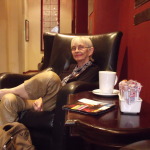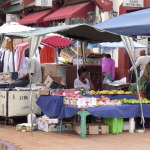After a good night of sleep I got a look at where I was. Our guesthouse features eight quaint rooms, a lovely garden and pool, wifi (thank god) and a delicious breakfast. After a winter in New England just to sit outside and enjoy the balmy air is a blessing.
Another blessing is how well the Dance Umbrella staff is taking care of us. They have arranged for our accommodations and for drivers to shuttle us back and forth to events. This removes a layer of stress –not having to negotiate all the logistics of a big foreign city. Now we can focus on the work! And of course we are hatching plans for some sightseeing around Joburg.
Today we attended the first in a series of daily artist talks with Nigel Channock led by South African dance critic, Adrienne Sichel. Nigel, the founder of DV8, is here teaching an intensive week-long workshop. Having reached a ripe old middle age in the dance world he is now mostly interested in creating improvisational performances. A passionate, irreverent and intensely expressive individual — Nigel talked about his current art making practice. While he creates multi-disciplinary work, when asked about using video he said he did not and proceeded to discuss ‘live’ and ‘dead’ work—dead being anything that is being re-presented and is thus static (painting, photography, film, sculpture, etc). What matters most to him at this point is for the performers to be passionately engaged and enjoying the working process. The audience has become a secondary concern if one at all. A handful of his workshop participants listened with rapt attention as he held forth.
The talk took place at the famed Market Theatre a hotbed of arts activity. It is a wonderful building set in a sort of arts district that includes the National Arts Council, French Institute, Museum Africa, an art school, and a fabulously decorated restaurant that serves wild game. All around the theater are vendors selling jewelry, carvings, instruments, clothes and food.
After the talk we had a chance to chat with Adrienne Sichel. She is one of the founder of Dance Umbrella and has been at the heart of the dance scene since the 70’s. She began to fill us in on recent developments in the arts in South Africa. It seems Zuma’s conservative/traditional approach to governing does not bode well for the arts. Already there are signs of a crackdown on experimental or political work. There are threats of funding bing withdrawn. Apparently the Minister of Culture perceives arts in a most traditional vein. Many of those in government posts who oversee arts funding have little interest or knowledge of the field. What has been a rich and vibrant arts scene for many years may be entering a dark and desperate period. We will certainly hear more about this from the artists in the days to come.
After a hearty lunch of lamb shank stew and a rest it is off to Vincent Mantsoe’s performance of his newest work, “San.” The performance takes place at Dance Factory, a leading center for dance in Johannesburg. A converted garage, the space includes a fabulous large, flexible black box theatre with a lobby bar and outdoor gathering spaces. It sits within another complex of arts related spaces that includes Moving Into Dance Mophatong, one of the most established contemporary companies in Joburg.
The performance was delayed due to technically difficulties so I got a good chance to survey the audience. It was a wonderful mix of ages, colors and backgrounds. Certainly the white, well-educated arts going crowd was there in force. But so are many young black artists/students and theatergoers. This is an audience that Dance Umbrella has worked hard to build. In Africa as in many other places in the world contemporary dance has a small audience — too small to support the work of those artists choosing to make Joburg their principal residence.
The piece “San” is performed by five dancers including Vincent, three French and two South African dancers. The set is comprised of strings stretched across the space every which way in geometric patterns including straight across the front at eye level. This construction or division of the space represents the artificial geographic barriers created by the Europeans when they came and divided up the South African region. These divisions inhibited the nomadic San people from moving about freely and radically changed their lifestyle . This and more I learn the next day at the artists talk with Vincent and Nelisiwe Xaba. The music score for the work is inspired by the great Persian poet, Rumi and performed (on tape) by the renowned Persian singer and master of the Persian classical repertoire. The program notes say, “one does not need to understand the words in order to appreciate the transformation of a language that speaks to the pure emotions.”
“San” takes one on a spiritual journey at once mysterious, desperate and divine. It evolves slowly as each dancer explores and expresses their experience of the stage environment and one another. The piece conveys struggle, connection, dependence, determination and a sense of loss. Speaking with Vincent afterward I learn that they had such technical difficulties that the lighting was seriously compromised for this opening performance.
Still navigating jet lag we departed immediately after the show with no hobnobbing. Socializing would have to wait as sleep beckoned. A deep sleep was disturbed when the gods began to roar deep in the night. A terrific thunderstorm raged for over an hour with torrential rains followed by two more hours of rumbling and grumbling. With the return of silence came sleep again until late in the morning.






